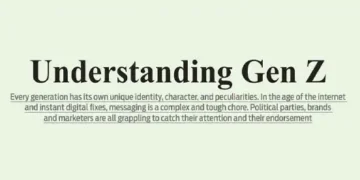K Srinivasan
FOR the uninitiated, Generation Z, or Gen Z, is the generation of people born between the mid to late 1990s and early 2010s. They are the generation after Millennials and before Generation Alpha.
An AI-generated Google factsheet on Gen Z outlines their attributes: q Gen Z is the first generation to grow up with the internet and are known as ‘digital natives’ q Gen Z is very media savvy, and marketers are challenged to connect with them q Gen Z is considered to be the most diverse and multicultural generation ever q Gen Z values experiences over material goods and seeks connection, individuality, and self-expression.
Watershed report
Recently the Boston Consulting Group, heavyweight global management consultant, in collaboration with Snap Inc, the parent company of Snapchat, produced a watershed report: ‘The $2 Trillion Opportunity: How Gen Z is Shaping the New India’. As the report states: ‘…. …. for marketers to truly harness this opportunity, they must gain a deeper understanding of who they are, what makes them tick, and what they value. Our conversations with brands throughout this study revealed that numerous questions and misconceptions persist about what truly drives this generation. We undertook a study encompassing over 2,000 Gen Zers and 1,000 millennials in India to develop this perspective.’’
The report is an absolute eye-opener on how this generation is going to shape the economic landscape of the subcontinent with the sheer force of their buying and consumption power. At present, their spending is around $860 billion equivalent to 43 per cent of India’s total consumption. It is anticipated that this figure will surge to $2 trillion by 2035.
The impact and influence of Gen Z on retail spending and their exceptional unique values and behavioural patterns that make it a challenge for how brands will recraft their strategies to engage with this generation was the triggerpoint for the report. What the report illuminates is that most brands are aware of this seismic change, but less than 15 per cent have moved to strategise and engage with this generation.
Surprisingly the political class has moved much faster to engage with this generation. As the Times of India rightly points out, “…it is this ‘wokeness’ which coerces political parties, their leaders, and governments to organise events like the National Content Creators Awards; to interact with India’s top gamers; to meet undergraduate students at Delhi University; to interact with Exam Warriors; to ‘reel’ each rally and garner likes, comments, views on Instagram; to partner with social media influencers like Ranveer Allahbadia (Beer Biceps), Kamiya Jaani (Curly Tales), Samdish Bhatiya (Unfiltered with Samdish); more so, to tap into their colossal influencer network, their millions of followers and the level of influence they bestow on public discourse.’’
One reason why political parties are increasingly gravitating towards a high-quality digital team to spread their message is because of the impact of social media and the digital highway on Gen Z. As the report says they are looking for “quick, visual, and interactive content”. Instant gratification is the name of the game and reels and endlessly scrolling through reels and guffawing at memes are pretty much par for the course. No wonder political parties have specialists working on memes round the clock. One great meme festival happened after Rahul Gandhi’s viral episode concerning jalebis at a rally in Haryana during the October elections in the state.
Complex, thankless
It is a complex and, frankly, thankless job for both political parties and brands to navigate across the spectrum from the silent generation (1928-1964) to Gen X (1965-80) to the Millennials (1981-1996) to Gen Z (1997-2012) to Gen Alpha (2013-). It is a vast and diverse swath of individuals with their tastes, preferences and idiosyncrasies. How do work on a strategy that can combine all these differing backgrounds? It is a communication challenge that those in the messaging business are grappling with. But at the core is Gen Z. After all they will be the group with the most muscle, the most cash to spend and the most potent in moving the market.
































